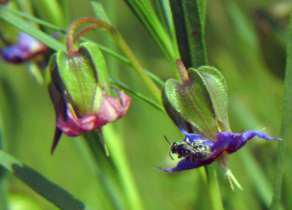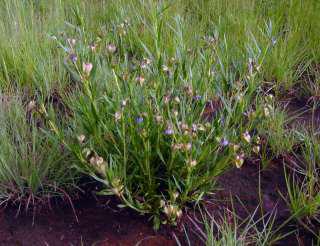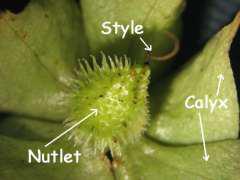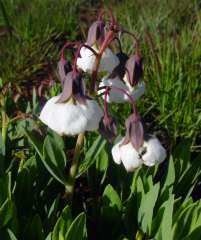Trichodesma angustifolium
Trichodesma angustifolium Harv. subsp. angustifolium
Family: Boraginaceae
Common names: blue-bells
Introduction
Dainty pale blue flowers that turn pink with age cover bushes of Trichodesma angustifolium subsp. angustifolium in springtime, especially after fire. These blue-bells which have much smaller flowers than their well-known sister species, the chocolate-bells, T. physaloides, are delicate and attractive.

Description
Description
Trichodesma angustifolium subsp. angustifolium is a perennial herb with annual stems from a woody rootstock. Rounded bushes up to 0.5 m high and 2.0 m in diameter and a roughly appressed indumentum (covering of hairs) characterize the species.

The leaves are narrowly linear, ± 20-50 x 3-6 mm. The inflorescences are borne terminally. The calyx of the flowers is winged, enlarging in fruit and the corolla is ± 9-15 mm long, the lobes triangular, long acuminate, often twisted, and deep blue. Flowering time: from October to May.

The fruit consists of 4 nutlets.
Conservation Status
Status
Trichodesma angustifolium subsp. angustifolium is not currently threatened. However, the grasslands in which they occur are threatened by human impact and this may change its status in the future.
Distribution and habitat
Distribution description
The genus is widespread in southern Africa and is represented in various vegetation types ranging from grassland and savanna to succulent shrubland, mainly in the Grassland and Savanna Biomes. All southern African species extend further north into Africa. Trichodesma angustifolium subsp. angustifolium is disjunct in its distribution in southern Africa and is found in Namibia, Botswana, South Africa (Northern Province, North-West, Gauteng, Free State, northern KwaZulu-Natal and Northern Cape) and Mozambique. Blue-bells grow in red, sandy loam and stony soils. This species is essentially found in the moist summer rainfall areas of southern Africa.
Derivation of name and historical aspects
History
The name Trichodesma is derived from the Greek words, thrix or trikhos (hair), and desme (band or bundle) and alludes to the twisted hairs or awns that terminate the anthers. The species name is a reference to the relatively narrow leaves.

The genus Trichodesma is a member of the family Boraginaceae (forget-me-nots) which comprises about 45 species from the tropical and subtropical regions of Africa, Asia and Australia. In southern Africa, five species and three subspecies are recognized. The related T. physaloides occurs in the same area as this species.

T. angustifolium subsp. angustifolium is closely related to T. africanum from the drier western parts of southern Africa. T. angustifolium subsp. argenteum differs from the typical subspecies in its silver-grey appearance due to a dense covering of hair and its distribution in northern Namibia.

Ecology
Ecology
With its sturdy and often very old, fire-resistant rootstocks and mass seed production after fire-stimulated flowering, this species is well adapted to survive unfavourable conditions. Most fire-stimulated plants flower in the absence of fire but not as profusely as they do after a fire. Plants reach a considerable age and large rootstocks may be more than a century old.
A prominent feature of the flower is the calyx which is strongly enlarged in the fruit. The plant sheds the nutlet(s) with the calyx and style attached. The entire floral structure is relatively light and serves as a dispersal unit. Blue-bells are subject to winter drought, regular natural fires and frost.
Uses
Use
Trichodesma angustifolium subsp. angustifolium is used for treating diarrhoea by grinding the dried root into a fine powder and adding it to cold water
Growing Trichodesma angustifolium
Grow
This plant is not in general cultivation, probably because it does not flower well unless subjected to fire (intense heat). It presents a challenge to the keen gardener to create a suitable environment for it.
References
- Leistner, O.A. (ed.). 2000. Seeds plants of southern Africa : families and genera. Strelitzia 10. National Botanical Institute, Pretoria.
- Pooley, E. 1998. A field guide to wildflowers of KwaZulu-Natal and the Eastern Region. Natal Flora Publications Trust, Durban.
- Retief, E. & Van Wyk, A.E. 2002. The genus Trichodesma (Boraginaceae: Boraginoideae) in southern Africa. Bothalia 32: 151-166.
- Smith, C.A. 1966. Common names of South African plants. Memoirs of the Botanical Survey of South Africa No. 35.
- Van Wyk, B.-E. & Gericke, N. 2000. People's plants: a guide to useful plants of southern Africa. Briza Publications, Pretoria.
Credits
E. Retief & S.P. Bester
National Herbarium
January 2008
Plant Attributes:
Plant Type: Perennial
SA Distribution: Free State, Gauteng, KwaZulu-Natal, North West, Northern Cape
Soil type: Sandy
Flowering season: Spring, Early Summer, Late Summer, Autumn, Winter, Sporadic/All year
PH:
Flower colour: Purple, White, Pink
Aspect: Full Sun
Gardening skill: Easy
Special Features:
Horticultural zones











Rate this article
Article well written and informative
Rate this plant
Is this an interesting plant?
Login to add your Comment
Back to topNot registered yet? Click here to register.